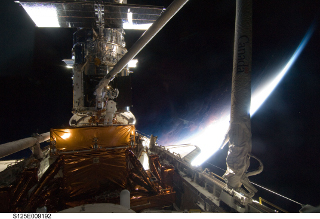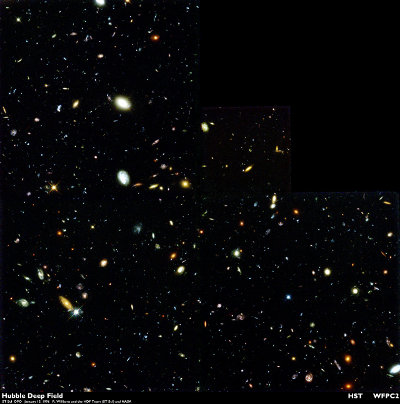Hubble Repair: A NASA astronaut installing Hubble's corrective optics. The Sun is rising over the Earth in the background.
Credit: NASA
Collectively, many invested scientists were able to design corrective optics for Hubble, but we were still unclear about how the astronauts would place the corrective optics in the telescope. The answer came to an engineer named Jim Crocker when he was taking a shower. He was in Germany for a meeting. In Europe showerheads are different than in the US. Instead of coming out of the wall above the faucet, they are mounted on a vertical pipe that can fold up against the wall. As Jim unfolded the pipe to adjust the showerhead, he realized we could do the same for Hubble. We could make a corrective optics unit that could move lenses into the path of light to reposition the light so it could focus properly. It would be like a complicated pair of eye glasses for Hubble.
We built it and called it COSTAR, but we had to wait until astronauts installed it in 1993 to see if it worked. Thankfully it did and Hubble’s new glasses provide amazing images of galaxies, nebulae and surprises such as the Hubble Deep Field. Through Hubble we are seeing the Universe as we never could have from Earth.
Hubble Deep Field: In 1995, the Hubble Space Telescope was pointed to a spot on the sky near the Big Dipper constellation for 10 days to collect all of the light it could. The resulting image, known as the Hubble Deep Field, revealed more than astronomers could have imagined: a 3-d image of this region of space with some nearby stars, hundreds of galaxies at varying distances, some of which are so far away that they are probably among the first that formed after the Big Bang. Since the galaxies were formed, most of interglactic space has been filled with very hot plasma, invisible to the naked eye as in the dark spaces in this picture.
Credit: STScI and NASA
As you can see, I was involved in many large ideas and projects during my life, all of which in one way or another involved plasmas. Even in the case of the Hubble Space Telescope I could not escape the plasmas in between the galaxies. I was so involved with plasmas that when my children were young, they would ask me what I did on a given day and I would say, ‘I was thinking what I would do if I were an electron.”



